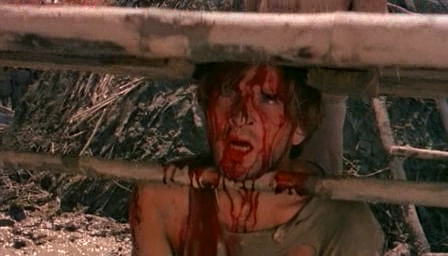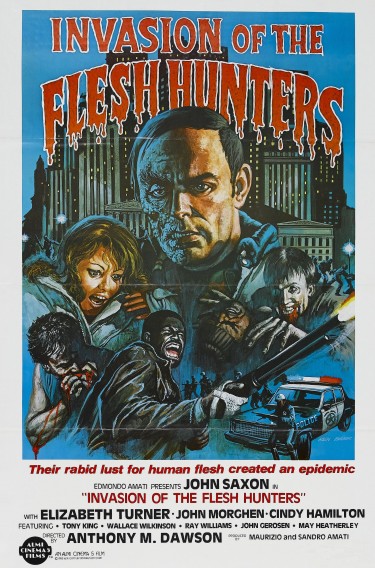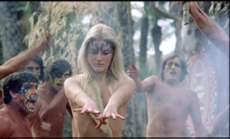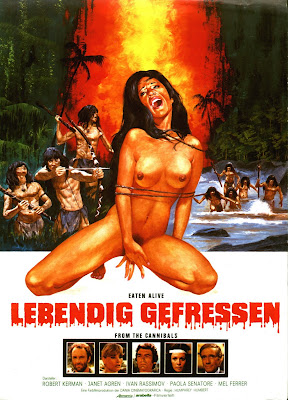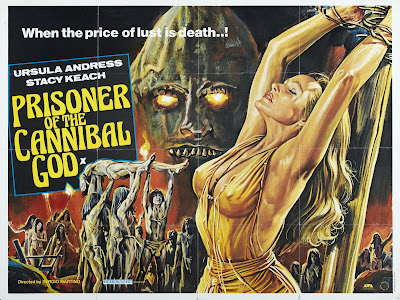There are a few examples of films being more than just raw stock projected on screens for the enjoyment of viewers. Pasolini's
Salò is one such film, as is Nabuo Nakagawa's
Jigoku. These are films not intended to simply horrify or anyway they do so much more. In their short running times they raise questions about life and death that many of our greatest works of literature don't have the deftness to propose. Steve Mcqueen's
Hunger comes to mind as a more recent example of a film having the power to do more than provoke happiness or sorrow from its viewer. He makes death and hardship beautiful and tragic in a way I had never encountered before. The film today isn't beautiful, but it does at times appear to be more than just a film. Like
Salò, it stems the tide of modern cinema by bombarding the viewer with images of vileness, torture, and rape in service of eschewing western beliefs and the safety of films and ends in a smorgasbord of sexualized violence. It is a film so lifelike, grim and ghastly that chanting "it's only a movie" simply doesn't cut it.
Cannibal Holocaust
by Ruggero Deodato

The film starts, weirdly, with an
Emanuelle And The Last Cannibals crib; I don't know if Deodato had watched Joe D'Amato's film, but it does seem rather conspicuous that both films start in pretty much exactly the same way. Robert Monroe of NYU's anthropology department is the subject of a news segment because of his planned trip to Brazil. He's going down there to find out what happened to filmmaker Alan Yates and his crew who went there to make a documentary about warring cannibal tribes and haven't been heard from for weeks. Once in the jungle he hires two guides from the military garrison monitoring the conflict who happen to have an ace up their sleeve: they have one of the natives captive. Using their injured native as something like a bloodhound, they are taken on a tour of the home turf of the Yakumo, a neutral tribe. After a few days being coddled by the Yakumo, Monroe and his guides go further down river to find the tribes that Yates was after. The three men save one of the tribes, the Yanamamo, from a war party of Shamatari, the other tribe. Monroe takes care to try and integrate himself into the Yanamamo society so that they might give him the cans of Yates' footage. After Monroe dines with him on a Shamatari captive, the chief agrees to let him take the film back with him.
Once back in New York, Monroe views the footage before allowing the news executives who paid for Yates’ expedition to see so much as a foot of film. The network did foot the bill after all, the least they might expect is some ratings in exchange for their losses. Monroe, having seen it, knows what a bad idea that is and insists they watch it first before they make any decisions (wouldn’t they anyway?). So Monroe sits down with the crew and together they watch The Green Inferno. On top of showing what became of Yates and his crew (his girlfriend Faye, two cameramen Mark and Jack, and one guide) it also becomes immediately clear that Yates got what was coming to him. If Yates had even a slight understanding of the region (that is to say the truth about the so-called cannibals) he would know that they wouldn’t be putting on the flesh-and-blood show he came down there for. So what did he do? He decided to invent a little savagery himself and force the hands of the tribes. Yates effectively became a one man colonial power; he and his crew burn down villages, murder and rape natives, kill animals for no reasons, he cuts off his guide’s leg after a snake bite resulting in the man’s death, and then shoots Jack when he gets injured so that when the natives find and kill him he can film it – that the natives attack and kill Yates and the others on camera should come as a shocker to no one. The executives finally see that running on this primetime would be the biggest mistakes of their careers and order the footage burned (which I don’t think news executives actually do; they aren’t the ministers of propaganda for a 40s fascist state). Reading about these things and seeing them happen in front of your face in one of the most convincing pieces of mock Cinéma vérité in history are vastly different things.
If you think I'm kidding about this being realer-than-reel listen to this. The film premiered in Rome in 1979 and was doing pretty well in its opening week until the proper authorities got involved. Ten days into the film's run, the police confiscated it, and Ruggero Deodato was hauled off to prison. He was about to be convicted of murder because to the police and the censors it appeared as though Alan Yates and co were actually raped, killed, and eaten by cannibals (Hey, they weren't the only ones who worried that Deodato was a murderer. Carl Gabriel York who played Yates was worried he was going to get killed for the sake of the film and was half-convinced it was a snuff film while he was down there. Robert Kerman who played Monroe thought Deodato was a cold son of a bitch, too. Perry Kirkanen who played Mark is supposed to have cried and wretched at the sight of a lot of the director's choice of setpieces). They gave Deodato 30 days to produce the actors as proof he hadn't fed them to the Yanamamo. Clearly not thinking that this was going to happen, Deodato had instructed his leads to lie low for a year, they’d even signed contracts to that effect. Finding and presenting them may have crushed one of the best laid publicity schemes in history, but it made way for quite another. The murder charges were dropped, but the obscenity charges stuck for four more years until he was able to argue his way into a heavily edited home video release. Japan, incidentally got it for a theatrical run and the film made thousands of dollars; it was the second largest grossing film that year after E.T. He was in point of fact, trying to make the harshest film ever made, so all things considered, Deodato made out ok in that now not only has he got the most fiercely manipulative movie on his resume, but also one of the more infamous. Try counting the countries in which
Cannibal Holocaust was banned, you’ll get somewhere around 30 before the proof runs out. And while at first that might seem like a stroke of particularly bad luck, isn’t that just the thing that 42nd street freaks eat for breakfast? Can you think of a better possible way to get people into grindhouse seats (today it would be foreign video hosting websites) than to say your movie was banned by more than two dozen countries? I didn’t think so.

There are many comparisons to be made here, most of which other, smarter people have already pointed out, so I'll stick with my impressions and the facts. Deodato had in the years immediately following
Jungle Holocaust, made other films; Cannibalism is not his one trick as many have suggested. His films
Last Feelings (1978) and
The Concorde Affair (1979) are both well regarded, which proves my point that Deodato was an actual moviemaker, not just a machine like Joe D'Amato or Jesús Franco. He had learned from an apprenticeship with Roberto Rosselini and knew quite a bit about making a convincing and involving story. That's why, when the opportunity arose to make another cannibal film, he said yes. Deodato had been fascinated with the stories of the Red Brigade, a terrorist group in Italy known for political assassinations. He watched a good deal of the media coverage and began wondering why no one thought to look into the media coverage. He thought that much of the footage seemed to be staged for the sake of the media, which struck him as being uncouth and just about the furthest thing from journalist integrity (he was also a fan of Mondo films like those made by Prosperi and Jacopetti, who I always like to point out,
bribed a judge to delay an illegal execution so they could film it!!!! for their movie
Africa Addio, so I leave it to him to tell the difference). Mix intensity, anger and deftness and some frightening shit is going to result, no two ways.
The reason for all the controversy comes from the last half of the film, the Green Inferno. Deodato went out of his way to make the first half, the framing segments look glossy and polished, which led me to believe that 1984 was the film's actual release date (the cinematography on the whole is years ahead of its time). This means that there are things that go pretty terribly awry in part 1. When Monroe arrives in the jungle, he and his guides witness a native man punishing his cheating wife. There's a lot not to like about this scene like the fact that the men could easily stop it, but don't, which I guess is a touch of the Red Brigade influence seeping in, but still...Fuck! The man molests her with a big stone phallus and then kills her with it, I didn't need to see that. From a logical standpoint, the scene looks preposterous because though the crew did their best to cover the girl in mud, she's clearly white. Her name is Lucia Costantini and she's the head of wardrobe; they had to have her in the scene because Surprise! Surprise! none of the actresses wanted to get raped with a stone in the mud. The change in cinematography also helps change the depiction of natives. In part 1, you see their faces up close, and they are not nearly so frightening as all that, in part 2, you can't see anything but menacing faceless bodies writhing around in the jungle. Finally, the real difference in part 1 and 2 is that in the found footage with the Green Inferno segment on it, the footage itself is thoughtfully and carefully degraded so that it looks like it was left in the jungle. Scratched, overexposed, shaky, and consisting of long takes edited with a hatchet, it perfectly mimics uncut documentary footage (evidently, the rest of the world thought so, too, hence Deodato's murder trial).
Which brings me to why this movie is so difficult to watch. The tedious first half is riddled with holes through which Deodato’s realism falls fast. The adulteress punishment, Monroe’s integration into the Yanamamo, the behavior of the Yakumo (who, like the natives in
Jungle Holocaust, play with his penis for an uncomfortable amount of time. That Kerman was a pornstar (you could find him in
Debbie Does Dallas if you cared to) and the girls were on loan from a brothel might explain why he doesn’t seem as bothered by it as Massimo Foschi in Deodato’s previous film), the helpful asides from our guide and the lazy not-quite-charming acting from Kerman makes the framing parts feel like the work of a lesser director. It makes sense that Deodato would try being a little less grim so that when the Green Inferno is shown, it is a total departure in tone, style, and everything else, but part 1 feels too boyishly naïve to be paired with the grizzly and cutthroat ending.

The Green Inferno is something that was so distressing and horrifying and confrontational that not too long after I had seen it, my brain had actually blocked a good deal of its content. I remembered vaguely that the murders were terrible and that the animal slaughter was repulsive, but after about a month or so, I couldn’t conjure up the images to go with the feelings of disgust or the order in which things happened. As I noted in my
Goodbye, Uncle Tom review, the way he presents the bodies of the cannibals, as a thriving mass, less than human, almost alien, is monstrous and it really frightens me. All of them dancing about and participating in the murders, all of them painted very inhuman colours; they are made to look evil, but they're just people driven to do horrible things. We don't get that, we don't really get their side of things other than in the actions of Yates and his crew, which is disproportionate to say the least. Murder and rape on one hand and murder and rape on the other, that isn't exactly easy to stomach. Beyond the characters, there's also the actions of Deodato and his crew to consider. Let’s talk animals, shall we? I don’t like seeing animals die (I’ve had pets all my life) and seeing them killed for the sake of a film-within-a-film was just ugly. A monkey is hacked up, a coatamundi (rodent not unlike a muskrat, which is what I thought it was) is stabbed, lizards and spiders are killed, a pig is shot, and then there’s the turtle. Right around the time Yates and co. torch the Yakumo village, they catch and kill a turtle so they can eat it. As I watched them take it apart, that’s when I realized that this was not an ordinary film. I’d seen a lot of violence, but never like this, never completely free of artifice; Deodato and this film suddenly seemed evil. In hindsight I get that this is supposed to be a comment on journalism, but I can’t put myself in that position; I cannot see myself suggesting that an animal (and a fucking turtle, no less) needed to have its dignity stripped from it as it is murdered; I’m not in PETA or anything, but that’s what it is, it’s murder. Accounts of the shooting are about as scary as one would expect.
Carl Gabriel Yorke was a young actor's studio graduate with no film experience, which is perhaps why his acting is so good; he had no ego and everything to prove. He and the other four members of the expedition do such amazing jobs (especially when paired with the wooden actors of the framing story) that it's easy to believe everything they say. And they were doing such believable jobs in spite of (or perhaps because of) the horrible treatment they underwent. Perry Kinkanen is supposed to have wept after they killed the pig, though you wouldn't know it from watching that scene, so brutal and chilling is his acting. After the rape of the Yanamamo girl, Yates and Faye are supposed to have sex as the homes of the Yakumo burn behind them. Yorke was a little nervous about the scene so Francesca Ciardi who played Faye actually suggested that the two go off and have sex somewhere in the jungle; he declined. He and Robert Kerman have both stated that Deodato was an unfeeling bastard and that everything was subordinate to the film. At one point during filming, the father of one of his actors died. Deodato did let him leave for the funeral, but you can still see him crying on film. Who the fuck would do that?
Deodato was effectively conditioning everyone in the audience to expect the worst from his characters. So they murder animals, burn down villages and rape women and just revel in the carnage. He was purposely stacking up acts of violence and debauchery so that the third act would be so devastating and he was doing it in the most realistic way he could have, short of actually killing people. The script stacks the odds against Yates getting out alive, but you don’t hate his crew as much as you hate him and yet they’re the ones who get the brunt of the punishment. First is the guide; he gets bitten by a snake, and not even a poisonous one, and Yates hacks his leg off; he dies shortly after. He then coerces Jack and Mark into raping a Yanamamo girl with him and shortly after they find the girl dead, stuck on a pole (the image you’re probably familiar with even if you’ve never seen the film), clearly punishment for her being raped; Yates spouts some bullshit about it being a purely sexual ritual so, one would assume, he could edit it later. Then he all but murders Mark after the cannibals come looking for retribution for the girl. Mark is injured by a spear and so Yates shoots him so they can catch up to him; he films from a short distance away as they castrate, dismember, and eat him. Somehow it only clicks what an unforgivable mess he’s made of things when the cannibals take Faye. He insists that he and Jack go back for her, but when he runs out of bullets, his only recourse is to hide in the bushes as Jack films her being raped, beheaded, and eaten. We don’t see Yates being properly punished, we just see his face as the camera falls out of Jack’s hands onto the ground. The ending is horrifying and pitch black in tone. Riz Ortolani’s music perfectly fills rounds out the soundtrack as a series of entirely-too-convincing murders are carried out by the pulsing throng of natives who have stopped being human; they are monsters. We’re told we need to consider who the real cannibals are. This movie, its proponents, and all that it stands for is unforgivable.

This is a movie about victims, collateral damage, but I don’t think that was Deodato’s intent. He, like Yates, wanted to excite and disgust and had no concern about whom or what got in his way. So, he behaved abhorrently, killed animals, treated his actors like shit, lied about the lives of two actual tribes who never asked to be treated with such disrespect, fed into stereotypes, fell into exactly the traps he supposedly set out to condemn and then got off essentially scot-free (albeit after a lengthy fight, but that was in no way proportionate to the crimes he committed). He was even allowed to make a third cannibal film (
Cut and Run in 1985) and he’s currently doing a fourth. He says he regrets the animal killings, he’s reportedly gone so far as to say the whole exercise was a mistake, but I don’t see that that makes up for it. The end didn’t justify the means and I don’t know how he could have thought they did, even as the intense realist he was 1979, desperate to prove he was an uncompromising genius. Well, he succeeded, I guess, he didn’t compromise and his film was so real looking that he was almost executed for it. So he’s clearly one of the most talented and meticulous filmmakers of our time, but no one’s ever going to recognize him; in fact if he had never made this film, he’d be just another Italian filmmaker. Deodato is sort of like a real-life Daniel Plainview from
There Will Be Blood (and yes, I know that Plainview was based on the real-life Edward Doheny but stick with me); he has an ocean of oil under his feet but no way to profit from it; in order to do so he has to cut all his ties and betray his beliefs. We might see the ending cannibalistic orgy and Plainview's bowling pin cudgeling as the same tragic collapse; both men finally achieve what they want to, but it's the end of the line.
It makes sense then that the only person dumb enough to, in the wake of this controversy, try and achieve Deodato-style infamy is Umberto Lenzi. In crafting the ultimate cannibal film, Deodato also obfuscated the whole genre; no one was ever going to outdo him. Did that stop Lenzi? Hell no! When Cannibal films became the full-fledged genre that they are today, Lenzi was at the forefront, trying to beat Deodato at his own game, oblivious to the fact that he had no hope of succeeding and that Deodato wasn’t paying attention, he was too busy trying to get his film screened. It didn’t matter anyway because by the time Lenzi had made his final cannibal film (
Make Them Die Slowly), people like Jesús Franco had gone in, churned out a dozen cheap-ass ripoffs and everyone stopped expecting things from the cannibal genre and graciously stopped in 1981. After
Cut and Run a few more appeared, a few as supposed sequels, but they were largely ignored. On the night he saw
Cannibal Holocaust, Sergio Leone, one of the great overrated directors of the 20th century, wrote Deodato a letter saying how much he liked his movie, but that it was going to get him in trouble and he was right for once in his life. The film earned something close to two million dollars before it was banned, so maybe its true that Italians get Italian films more than any outsider ever could. It does strike me that no one with any taste could ever pay money to see this movie more than once (or at all if you knew anything about it).

Recently the influence of
Cannibal Holocaust has been felt all over the world; A Japanese film was released in 2003 that claimed to be a
Cannibal Holocaust sequel; an independent Amercian film called
Welcome to the Jungle was made, clearly in homage to
Cannibal Holocaust, in 2007. Eli Roth has spoken of his debt to
Cannibal Holocaust and even put Ruggero Deodato in
Hostel Part II in a small role as…a Cannibal! There’s now a generation of young filmmakers and critics who completely missed the point and simply take the violence at face value no different from the violence in
Zombie or
Suspiria. If someone tells you that they like this film, they are either lying, trying to get you to think something about them or both. Cause if they actually do like it, like most people enjoy say
Pulp Fiction or
Raiders of the Lost Ark or
Casablanca or whatever, think about what that means. They like the murder, the animal deaths, the exploitation of other cultures for profit and the rape. I don't think, but can't prove, that Deodato made this movie so people could enjoy it, but I do know he regrets it. So, you know where it came from, you know what happened, and you know what it did. I’ll let you decide whether the world would be better or worse without
Cannibal Holocaust; you already know what I think.
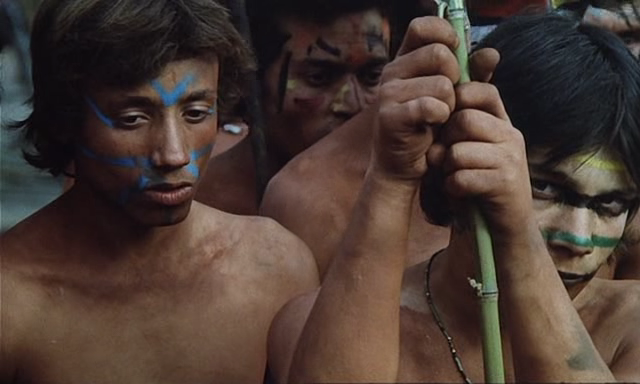
 My only real question is were the people at Eurociné that desperate to squeeze another dime out of the cannibal genre? Why else would you ask some spanish kids to make a movie for less money than it would take to fly some place that could pass for the jungle? And still, it was banned by the British Board of Film Classifications along with all its mean older brothers. That means that it took absolutely nothing to wind up on the banned list. This is why Make Them Die Slowly feels like such an empty gesture; what could you say about the cannibal genre now that films like this were being made, especially when you created it? What legs could you possibly have to stand on? So I say Brava, Alain Deruelle! Your incompetence is a greater victory than you know.
My only real question is were the people at Eurociné that desperate to squeeze another dime out of the cannibal genre? Why else would you ask some spanish kids to make a movie for less money than it would take to fly some place that could pass for the jungle? And still, it was banned by the British Board of Film Classifications along with all its mean older brothers. That means that it took absolutely nothing to wind up on the banned list. This is why Make Them Die Slowly feels like such an empty gesture; what could you say about the cannibal genre now that films like this were being made, especially when you created it? What legs could you possibly have to stand on? So I say Brava, Alain Deruelle! Your incompetence is a greater victory than you know. My only real question is were the people at Eurociné that desperate to squeeze another dime out of the cannibal genre? Why else would you ask some spanish kids to make a movie for less money than it would take to fly some place that could pass for the jungle? And still, it was banned by the British Board of Film Classifications along with all its mean older brothers. That means that it took absolutely nothing to wind up on the banned list. This is why Make Them Die Slowly feels like such an empty gesture; what could you say about the cannibal genre now that films like this were being made, especially when you created it? What legs could you possibly have to stand on? So I say Brava, Alain Deruelle! Your incompetence is a greater victory than you know.
My only real question is were the people at Eurociné that desperate to squeeze another dime out of the cannibal genre? Why else would you ask some spanish kids to make a movie for less money than it would take to fly some place that could pass for the jungle? And still, it was banned by the British Board of Film Classifications along with all its mean older brothers. That means that it took absolutely nothing to wind up on the banned list. This is why Make Them Die Slowly feels like such an empty gesture; what could you say about the cannibal genre now that films like this were being made, especially when you created it? What legs could you possibly have to stand on? So I say Brava, Alain Deruelle! Your incompetence is a greater victory than you know.
